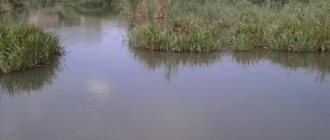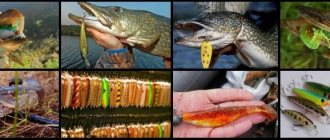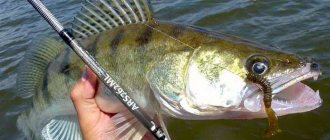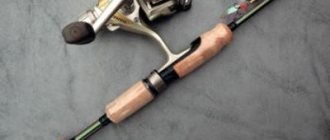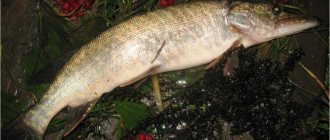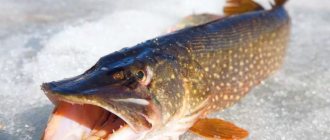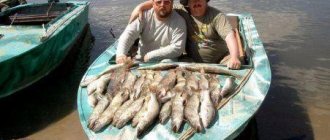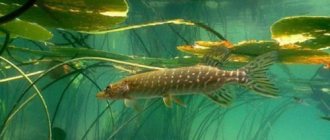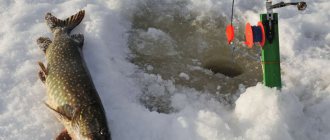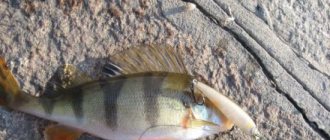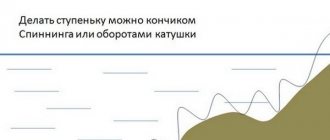Catching pike with a jig in the fall is the most effective way of fishing with a spinning rod. In the autumn months, the peaceful slave stops feeding and leaves its usual places, and the pike, on the contrary, begins to wander in search of food; this time is called zhora time, when the largest specimens can be caught. Many fishermen are waiting for this time, because in the summer there is less catch on spinning rods.
Where to catch pike on a jig in the fall
Basically, pike are caught with jigs in the fall in the bottom layer, up to a height of approximately 0.5 m from the bottom. Usually, a river, backwater or lake is chosen for fishing for toothy predators.
In practice, it has been proven that the most effective places are:
- Pits;
- Brovki;
- Places next to snags;
- Near fallen trees;
- Not far from coastal vegetation.
Important! The most effective and popular jig fishing will be places with pits and their surroundings, and the pike does not stand in the pit itself, it lurks in ambush at the entrance or exit, in bays and sides of rivers.
Fishing for pike perch in September
Autumn pike perch fishing usually begins in early September. In the first autumn days, you can safely go night fishing - night fishing for pike perch in the fall with a jig is always successful. It is at night, when there is no extraneous noise, that pike perch are caught on a jig head. Not every angler knows that it is at night that pike perch are great at jigging. Night fishing for pike perch with jigs in the fall is due to the fact that pike perch gradually begins to move to wintering areas - these are deep places in the reservoir where jigs are most relevant.
Specifics of catching pike with jig in autumn
In autumn fishing, a lot depends on the month in which we hunt the toothy predator. If in spring and summer pike swims throughout the entire reservoir, then in autumn it chooses the bottom layer with uneven bottoms.
In September it can be caught on spits and in coastal vegetation on the near edges.
In October it can be caught on the middle edges and yet sometimes it goes to the middle edges.
In November, the pike goes deeper into the reservoir.
Watch the video: Fishing for pike with a jig in November
Tackle for catching pike with jig
A jig rod must have a fast action. Test characteristics depend on the type of reservoir where fishing takes place:
- On lakes and other bodies of water with minimal current, the upper limit of the test range most often does not exceed 20 grams,
- on a river with a moderate current and a depth of up to 15 meters, the upper test bar can reach up to 50 grams.
Rod length
- If we fish from the shore, it can reach up to 3.3 m.
- A boat jig with a length of about 2 meters will be convenient.
The reel must be balanced with the rod and have high traction characteristics.
The laying of the fishing line should be as even and high quality as possible.
If we use braid, then the presence of an aluminum spool on the reel is mandatory.
As a rule, jig fishermen choose braided line. Although monofilament fishing line also has a right to exist in jig gear.
The thickness (Number) of the braid depends on the weight of the baits and fishing conditions.
- For a standing reservoir (lake, creek), the best option would be a wicker with a diameter of 0.1 mm,
- and for a river it is advisable to use a thicker version of about 0.15 mm.
When fishing for pike, it is necessary to use a special leash, since the predator often grinds the fishing line with its teeth.
Today the market offers a wide selection of leashes. One option is a fluorocarbon leader.
It is almost invisible in water, but is significantly inferior in strength to other options. Despite the abrasion resistance of fluorocarbon, pike teeth sometimes grind it down.
A steel leader is the most reliable, but on the other hand, it is more noticeable and can scare away the fish.
Interesting! You can make a steel leash with your own hands from the first or second string of a guitar.
Jig fishing technique
To successfully catch pike perch, you need to be able to read the topography of the reservoir, have a good feel for the bottom and skillfully control the bait when retrieving it. In total, there are 5 types of jig wiring:
Aggressive wiring
First, the bait sinks to the bottom, and after that, with the help of quick and sharp lifts of the rod, the bait is thrown up, with its release into the middle layers of the water. The use of such wiring imitates the movements of a fish, which, being in constant sharp movement, sinks to the bottom. This effect is achieved by moving the rod to a horizontal position. At the same time, you need to reel in the fishing line so that you always have contact with the bait.
Good efficiency of this type of wiring is observed with high fish activity, clear water and its temperature above 12–15 degrees. Under other conditions, the success of using this wiring may be insignificant.
Classic stepped wiring
This type of wiring is the most common when using jig baits. The rod is transferred from a horizontal position to a vertical position using three to five sharp and short twitches. As a result of this, the twister or vibrotail moves abruptly into the middle layers of water at a significantly lower speed than in the previous case. The line must be kept taut all the time to maintain contact with the bait, which gradually oscillates to the bottom. This type of fishing is especially effective when catching large specimens of predatory fish.
The use of stepped wiring gives a good result in muddy water and a fairly low water temperature, as well as in the presence or absence of a current.
Wiring for demolition
Such wiring is most productive in cold weather, when predators prefer to stick to the bottom. The best results are obtained using a “boot” jig head. After casting, the bait is pressed to the bottom by water and moves as a result of the influence of the current. In this case, it is very important to select the desired weight of the jig head. With a large mass, the jig head will plow the bottom and often cling; with a small mass, it will pass over the bottom without attracting a predator.
Bouncing on the bottom
This wiring is used for catching predators in still water. After lowering the bait to the bottom, with the help of rod movements it is forced to make short and small jumps, no higher than 4–7 cm, above the bottom. The line must be kept taut at all times. After twitching, the rod is left in a horizontal position, or after about 1 second it is moved to a vertical position.
This placement of the bait creates the appearance of the fish searching for food at the bottom of the reservoir. The use of this wiring allows you to fish small areas of the reservoir, but if the predator is located much higher than the bottom, this method does not work.
Choosing a jig head and bait for autumn pike fishing
Silicone and foam fish are equipped with a jig head or a Cheburashka weight with a hook.
The weight of the bait should be selected in such a way that after 2-3 turns of the reel the bait falls to the bottom in about 5 seconds. When biting passively, it is advisable to reduce the weight of the bait, and the game will be smoother.
There is an absolutely opposite technique - the weight of the bait is specially increased so that when it falls, it falls to the bottom with great force and creates a cloud of turbidity. When fishing for pike with silicone in the fall in snags, it is absolutely justified to use a bullet-type head weight.
Today's selection of jig baits is so diverse that silicone for pike in the fall can be chosen to suit every taste.
In jig fishing, using vibrating tails for pike in the fall is the most promising option. This bait is a soft and flexible fish. The length of such a silicone fish should be about 10 cm. It is not advisable to use smaller baits, since we expect to catch hungry and large specimens. And in late autumn, in the vicinity of the pits, you can use silicone fish baits up to 20 cm long.
Today, edible silicone has appeared on the market in a wide variety of colors.
Another rubber option for pike in the fall is a twister. This is an excellent option for fishing in heavy snags, complete with an offset hook, which is hidden in the body of the bait.
In addition to the offset hook, the twister can also be equipped with a tee or double. Twisters without flavors are rarely found today, and the market offers a wide range of different flavors. In the fall, a rubber band for pike can be equipped with noise chambers and create a rattle effect when playing. The body of the twister can be decorated with pieces of thread or pierced with silicone slices.
The color range of silicone baits is very extensive. Definitely, the assortment should have natural colors - light belly and dark back. Sometimes, in the most hopeless moments, poisonous colors come into play. Color designs using sparkles are widely popular; such baits have a defiant effect on predators. In addition to the legendary silicones listed above, examples of catchy silicone lures for pike in the fall are lucky john, Fanatik, Bait Breath, Keitech.
Foam rubber bait is used very rarely when fishing for pike. To a greater extent, foam rubber is intended for catching pike perch. However, for jigging, dragging or demolition, a foam fish is better suited. And when all the techniques and baits have been tried, then it also makes sense to try foam rubber dragging.
Spinner is a classic bait with half a century of age. Oscillating and front-loaded rotating versions of spinners are suitable for jig fishing.
As a rule, spinners are used on reservoirs with a clean bottom, because even slight vegetation and a small number of shells will appear almost immediately. Watch the video: The best silicone lures for catching pike in the fall
Despite the fact that fishermen often prefer silicone baits, spinners are a must-have in your assortment, since there are times when it is the spinners that shoot. There are world-famous brands of spinners that are hard for pike to resist. Such oscillators include ACME, Kuusamo, Mepps. Watch the video: How to properly rig jig baits
Choosing a jig bait for pike
To catch pike with a jig, large silicone baits with a length of 7 to 15 cm are used, depending on their type, for example, twisters are taken from 7 cm long, and worms from 12 cm. Do not worry about their too large size, since even small pike willingly attack large baits. True, there are days when catching pike with a jig is successful with small baits, so you need to have them in your kit.
The size and type of bait can be influenced by fishing conditions, so in a strong current, a large and bulky bait will sail strongly, preventing normal fishing. And for long-distance casting, they are much worse suited than small and compact attachments.
When choosing a bait, it is worth considering that a wide-bodied bait is perceived by pike as a larger prey than a narrow-bodied one. Moreover, the wider the nozzle, the longer it glides and hangs in the water when retrieved, which means that heavier weights are needed.
For active pike, baits with a clearly defined action are used (twisters and vibrotails); for passive ones, worms and creatures are used.
The silicone from which baits are made can be edible or inedible; of course, edible silicone is more catchy.
Lures have different degrees of silicone hardness, so for fishing in still waters and slow currents, it is better to use soft baits, and for strong ones, hard ones.
When fishing in snags, anglers often use foam fish. These baits are cheap to make and easy to make yourself. So if the tackle breaks, you won’t be as upset as if there was an expensive bait on the hook. Foam rubber fish are made from 10 cm long and about 2.5 cm thick.
Techniques for catching pike with jigs in autumn
When fishing with jigs, a novice fisherman can use the so-called basic step fishing:
- You cast and wait for the bait to fall to the bottom. This can be determined when the tip of the rod trembles, but if it is too harsh due to the sag of the fishing line.
- Then we pause for 1-4 seconds, the deeper the reservoir, the longer the pause. Sometimes there is a bite at the moment when the spoon touches the bottom.
- With a sharp movement of the rod, you open the bait from the bottom, while simultaneously reeling the slack line onto the reel. If at this moment you feel heaviness, then you need to cut.
- Winding the fishing line onto the reel, you draw the bait at a distance of 1-2 meters. The bite will look like a sharp jerk.
- You stop the wiring, the spoon falls to the bottom again and repeat everything from the beginning.
- It is recommended to count how long it will take for the spoon to sink to the bottom. The longer the descent time, the deeper. This technique will help to identify changes in relief, holes, and mounds.
Often this technique brings positive results. In the autumn, pike are hungry and grab the bait, so standard denim wiring is often enough.
In addition to standard jig wiring, the spinning player’s assortment also includes a certain number of auxiliary wiring: zigzag; pendulum; for demolition; dragging along the bottom. A separate type of jig can be called vertical lure. With this method of fishing, the spinning angler floats on a boat and hits the bottom of the reservoir with a jig bait. In this case, a short fishing rod with a round Nevskaya-type reel is used.
Postings
During the cultivation of this type of fishing, jig wiring has acquired a number of distinct directions, which are considered basic in jig technology. Based on these techniques, spinning anglers, adding certain technical techniques to them, such as pauses, jerk length and bait toss height, practice their own jigging technique. We will present to the reader fundamental methods of posting that will help to understand the principles of jig fishing.
American way
The wiring technique is based on the animation of the bait using a fishing rod. After casting, the jig head is allowed to sink to the bottom and two or three pulls of 15–20 cm each are made with the spinning rod, and during a subsequent pause, reeling out the slack line. Thus, the equipment is carried out along the selected trajectory, selecting the length of the pauses and the magnitude of the pulls depending on the bites.
Step view
This method is based on animation of the bait with a reel. After the rig touches the bottom, the reel is made two or three full turns, alternating such winding of the cord with a pause. During the pause, the bait, raised from the bottom and making a step at each turn of the reel handle, falls to the bottom again. As in the previous case, by increasing the pause time, the optimal wiring rhythm is selected.
Aggressive wiring method
This technique is used in the complete absence of bites, when you need to force the predator to pay attention to the installation by sharply moving the equipment. The wiring style is similar to twitching. The bait is torn from the bottom with a sharp jerk of the rod; this is achieved by lifting the quiver tip of the tackle upward, throwing it 20–30 cm in the water column. After a pause, the spinning rod is returned to a horizontal position, while simultaneously reeling out the slack cord. The jig bait for pike acts with sharpness of movement and is attacked during a pause, after the first couple of jerks.
Carrying out demolition equipment
The demolition technique is carried out according to the principle of the American method of fishing, only fishing is carried out on the current. During the pause between pulls, the bait lifted from the bottom by the force of the current is carried along its course, and the excess cord is wound onto the spool of the reel. During demolitions, such silicones as twisters and worms perform well, the natural movement of which due to the forces of the current does not go unnoticed by the toothy one.
Uniform type of wiring
The most technically complex type of fishing, requiring the angler to strictly control the bait in the water column. Various water horizons are fished using this method. After casting, the bait is not placed on the bottom, but having reached a certain level, they begin a uniform reeling, during which a pause is made, moving the bait to a lower level, and when reeling begins, returning to the initial horizon. Thus, the installation makes wave-like movements in the water column. Otherwise, this technique is called pelagic jig.
Features of catching pike with jig from the shore, boat and at night
You can catch pike with a jig both from the shore and from a boat. Tactics mainly come down to surveying and fishing for potential pike shelters. Fishing for pike with a jig in the fall from a boat allows you to fish anywhere in the river. If there is an echo sounder that will help you examine the bottom, this will increase the chances of not coming home without a catch.
Watch the video: Autumn jig fishing (fishing techniques and tactics)
Fishing from the shore is less effective, as it requires the fisherman to cover long distances along the shore.
Both when fishing from a boat and when fishing on the shore, success is guaranteed if fishing spots are known that have previously yielded catches.
Watch the video: Catching pike with a jig in the fall from a boat
Many anglers go fishing for pike with a jig at night. To effectively control the retrieve and bites, a firefly is attached to the end of the rod.
By the way! In addition to the rod and reel itself and a set of baits, when fishing, a spinning angler will also need such a device as a hook. Without a hook, it will be difficult to drag the catch into the boat.
Night fishing for pike perch on a jig
For fans of pike perch fishing, fishing for pike perch at night with a jig in the fall will be a real adventure. The technique for fishing for pike perch at night is the same, and, as practice has shown, the coloring of a twister or vibrotail is not particularly important and various silicone “fireflies” do not perform better than ordinary ones.
Again, it all depends on the wiring technique you choose, proper execution, and of course the presence of pike perch in the given water area of the reservoir. For this reason, night fishing for pike perch in the fall requires careful preparation. It is necessary to choose a place for fishing in advance, since at night you can’t really walk around the reservoir and you can’t see any landmarks. A flashlight on a boat to mark it in the water area and a personal headlamp, as you yourself understand, are simply necessary things.
The light from a small lantern does not scare the pike perch at all. In addition to jig baits, take with you submersible wobblers. Night fishing for pike perch with jigs in the fall is possible both with jig baits and well-buried wobblers, and placing them in the bottom level can also give an excellent result.
Perfect pike weather
When catching a predator, do not forget about the weather. With sudden changes in atmospheric pressure, the predator becomes inactive and refuses to respond to the offered bait. A warm cloudy day with drizzling rain is most suitable for pike.
Autumn fishing is different from spring or summer. In nature, all processes slow down, and the activity of fish also decreases. Before wintering, pike tries to gain fat, so it rushes at everything that moves past it, so the right tactics and bait will bring good luck to the fisherman and allow him to catch the heaviest, toothy trophy.
